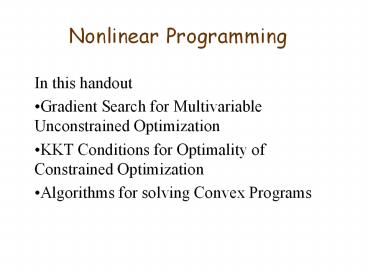Nonlinear Programming PowerPoint PPT Presentation
Title: Nonlinear Programming
1
Nonlinear Programming
- In this handout
- Gradient Search for Multivariable Unconstrained
Optimization - KKT Conditions for Optimality of Constrained
Optimization - Algorithms for solving Convex Programs
2
Multivariable Unconstraint Optimization
- max f(x1,,xn)
- No functional constraints.
- Consider the case when f is concave.
- The necessary and sufficient condition for
optimality is that all the partial derivatives
are 0. - But in most cases, the system of equations
obtained that way cant be solved analytically. - Then a numerical search procedure must be used.
3
The Gradient Search Procedure
- The gradient at a specific point xx
- The rate at which f increases is maximized in the
direction of the gradient. - Keep moving in the direction of the gradient
until f stops increasing.
4
Examples on the board.
5
Constrained Optimization
- max f(x1,,xn)
- subject to gi(x1,,xn) bi
- x1,,xn 0
- The necessary conditions for optimality are
called the Karush-Kuhn-Tucker conditions (or KKT
conditions), because they were derived
independently by Karush (1939) and by Kuhn and
Tucker (1951).
6
KKT conditions
The conditions are also sufficient for optimality
if f is concave and gis are convex.
7
Connection of KKT conditions for NLP to
Complementary Slackness Conditions for LP
8
KKT conditions
- The KKT conditions are also sufficient for
optimality if f is concave and gis are convex. - uis can be interpreted as dual variables then
KKT conditions are similar to the complementary
slackness conditions of linear programming. - For relatively simple problems, KKT conditions
can be used to derive an optimal solution. For
example, KKT conditions are used to develop a
modified simplex method for quadratic
programming. - For more complicated problems, it might be
impossible to derive a solution directly from KKT
conditions. But they can be used to check whether
a proposed solution is optimal (close to optimal).
9
Algorithms for solving Convex Programming
problems
- Most of the algorithms fall into one of the
following three categories. - Gradient algorithms, where the gradient search
procedure is modified to keep the search path
penetrating any constraint boundary. - Sequential unconstrained algorithms convert the
original constrained problem to a sequence of
unconstrained problems whose optimal solutions
converge to the optimal solution of the original
problem (for example, the barrier function method
used in interior-point methods for linear
programming).
10
Algorithms for solving Convex Programming
problems (cont.)
- 3) Sequential-approximation algorithms. These
algorithms replace the nonlinear objective
function by a succession of linear or quadratic
approximations. Particularly suitable for
linearly constrained optimization problems. - One example is Frank-Wolfe algorithm for the
case of linearly constrained convex programming.

